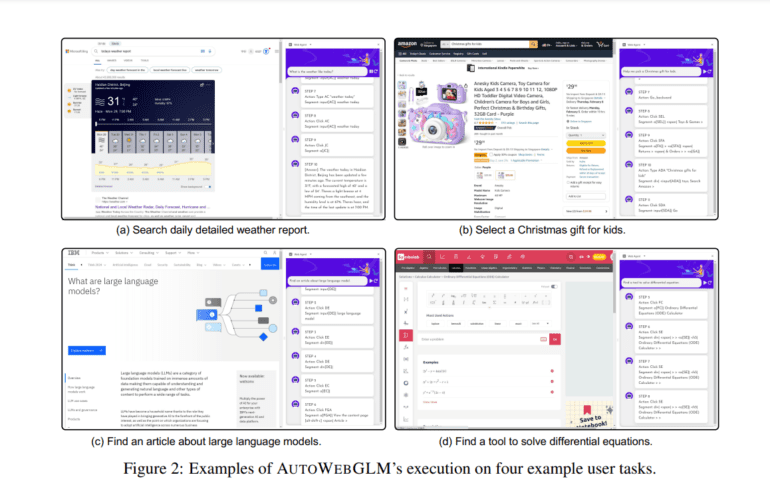- AutoWebGLM is an advanced automated web navigator surpassing GPT-4 capabilities.
- Key challenges addressed include versatile webpage actions, HTML text processing, and decision-making complexity.
- Innovations include an HTML simplification algorithm, hybrid human-AI data generation, and reinforcement learning techniques.
- AutoWebGLM’s development highlights curriculum learning, dataset curation, and performance validation.
- Its effectiveness is demonstrated through competitive performance and usability thresholds.
Main AI News:
In the realm of intelligent agents, Large Language Models (LLMs) have emerged as indispensable tools, particularly in the domain of web navigation. The fusion of self-governing digital agents, powered by LLMs, holds immense promise in reshaping the human-technology interface. These agents, armed with exceptional cognitive abilities and swift responsiveness, unlock unprecedented avenues of possibility.
Yet, the efficacy of current agents often falters when confronted with the demands of real-world web navigation. This shortfall can be attributed to three primary factors:
- Versatility of Actions on Websites: Traditional agents struggle to navigate webpages efficiently due to the myriad actions and interactions they entail.
- HTML Text Processing Capacity: The sheer volume of HTML text on webpages exceeds the processing capacity of typical models, leading to suboptimal performance and incomplete comprehension.
- Complexity of Decision-Making: Navigating the open-domain web necessitates rapid and relevant decision-making, presenting a challenging environment for agents.
To address these challenges, a pioneering team of researchers has introduced AutoWebGLM, an automated web navigator that transcends the capabilities of GPT-4, built upon the ChatGLM3-6B paradigm. This groundbreaking solution encompasses several key advancements:
- HTML Simplification Algorithm: An innovative algorithm has been devised to streamline HTML content, preserving essential information based on human browsing behaviors. This optimization enhances the model’s ability to comprehend webpage material effectively.
- Hybrid Human-AI Data Generation: High-fidelity web browsing data is curated using a hybrid approach that melds human expertise with AI capabilities. This meticulously crafted dataset forms the backbone of AutoWebGLM’s training regimen, facilitating continual improvement and learning.
- Reinforcement Learning Techniques: Leveraging reinforcement learning, coupled with rejection sampling, empowers AutoWebGLM to autonomously navigate webpages, execute browser actions, and tackle tasks with agility. This adaptive approach enables the model to refine its strategies in response to real-world encounters.
Furthermore, the team has developed AutoWebBench, a multilingual benchmark, to evaluate AutoWebGLM’s performance across diverse linguistic contexts. Through rigorous testing on various web navigation benchmarks, AutoWebGLM has showcased its efficacy while shedding light on areas that warrant further refinement.
The team’s primary contributions can be summarized as follows:
- Development of AutoWebGLM: The team has spearheaded the creation and deployment of AutoWebGLM, a self-sufficient web browser adept at online surfing activities. By integrating curriculum learning and self-sampling reinforcement techniques, complemented by rejection sampling fine-tuning (RFT), the model undergoes robust training in the web surfing domain.
- Dataset Curation: A comprehensive dataset comprising 10,000 records of actual webpage viewing activities has been meticulously assembled through manual curation and model-assisted techniques. Additionally, the introduction of AutoWebBench facilitates standardized evaluation across English and Chinese linguistic domains.
- Performance Validation: Through exhaustive testing, the team has demonstrated that AutoWebGLM, boasting 6 billion parameters, competes favorably with state-of-the-art LLM-based agents. Surpassing usability thresholds, AutoWebGLM exhibits tangible efficacy in addressing the intricacies of real-world web navigation.
Conclusion:
AutoWebGLM represents a significant advancement in web navigation technology. By addressing key challenges and leveraging innovative methodologies, it achieves competitive performance and tangible usability. This breakthrough has profound implications for the market, signaling a new era of efficient and adaptive web navigation solutions that can revolutionize user experiences and streamline digital interactions. Businesses operating in the digital realm must take note of these advancements and consider integrating such cutting-edge technologies to enhance their competitive edge and meet evolving consumer demands.

